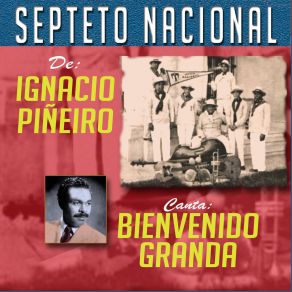Septeto Nacional De Ignacio Pineiro (feat. Bienvenido Granda)
Download links and information about Septeto Nacional De Ignacio Pineiro (feat. Bienvenido Granda) by Septeto Nacional De Ignacio Piñeiro / Septeto Nacional De Ignacio Pineiro. This album was released in 1998 and it belongs to Latin genres. It contains 14 tracks with total duration of 43:06 minutes.

|
|
|---|---|
| Artist: | Septeto Nacional De Ignacio Piñeiro / Septeto Nacional De Ignacio Pineiro |
| Release date: | 1998 |
| Genre: | Latin |
| Tracks: | 14 |
| Duration: | 43:06 |
| Buy it NOW at: | |
| Buy on iTunes $9.99 | |
Tracks
[Edit]| No. | Title | Length |
|---|---|---|
| 1. | Calla Campanero (feat. Bienvenido Granda) | 3:04 |
| 2. | A Gozar La Conga (feat. Bienvenido Granda) | 2:50 |
| 3. | Carta De Amor (feat. Bienvenido Granda) | 2:59 |
| 4. | Juramento En Las Tinieblas (feat. Bienvenido Granda) | 2:53 |
| 5. | Bardo (feat. Bienvenido Granda) | 3:10 |
| 6. | Libre Albedrio (feat. Bienvenido Granda) | 3:03 |
| 7. | Cadencias Tropicales (feat. Bienvenido Granda) | 3:00 |
| 8. | Congo Se Divierte (feat. Bienvenido Granda) | 2:54 |
| 9. | Lo Aprendio Sonando (feat. Bienvenido Granda) | 3:07 |
| 10. | Querida Nena (feat. Bienvenido Granda) | 3:00 |
| 11. | Pae Pae (feat. Bienvenido Granda) | 3:12 |
| 12. | Efi Embemoro (feat. Bienvenido Granda) | 2:48 |
| 13. | Dulce Desengaño (feat. Bienvenido Granda) | 3:34 |
| 14. | Desvano (feat. Bienvenido Granda) | 3:32 |
Details
[Edit]Developed in Oriente Province out of a mix of African, Spanish, Haitian, and French influences, the son became the bedrock of popular Cuban music for most of the 20th century: rumbas, boleros, mambos, and later salsa rhythms were all born out of the son song form. The son not only gave Cuba its own musical identity, but became the most influential musical export to emerge from the Western Hemisphere — in one of the finest examples of cultural cross pollination, pioneers of soukous and highlife music in central and western Africa were greatly influenced by various sones, which were initially inspired by African rhythms. The classic sextet configuration of early son outfits (including bongos, maracas, claves, tres guitar, and two lead vocalists or soneros) was first brought to Havana by the trailblazing Setexto Habanero (originally called Trio Oriental after the province they came from), which in turn inspired equally important groups headed by Miguel Matamoros and the bassist Ignacio Pineiro. Pineiro expanded the son sound, adding trumpet and a bit of swing to the mix with his Septeto Nacional. After a stint with Cuban singer Maria Teresa Vera, Pineiro began recording on his own in 1927, the early fruits of which are heard on this fine Tumbao collection. Including 17 mostly original son, bolero, rumba, and guaracha numbers, these 1928-1930 recordings offer a prime glimpse into the golden era of Cuban music.